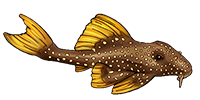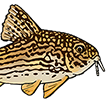https://doi.org/10.1590/1982-0224-2024-0058
Keywords: Chromosomal evolution; Karyotypic similarities; Paracentric inversion; rDNA-FISHAbstract
Disagreements in molecular and morphological analyzes have generated conflicts about the correct allocation of in Hypostominae. In this study, cytogenetics analyzes in four populations of H. fuliginosus from tributaries of the Uruguai Riverrevealed 2n = 56 chromosomes (30m + 18sm + 6st + 2a) for all populations. Nucleolar organizer regions (NORs) were located on the short arm in terminal position of the subtelocentric chromosome pair 25 in all population, in addition to Antas River population showed a structural polymorphism (three different phenotypes). Physical mapping of 5S rDNA showed cistrons in pericentromeric position on the short arm of the metacentric chromosome pair 12 in all the populations. Centromeric heterochromatins are present in almost all chromosomes, and conspicuous CMA3+/DAPI- blocks coincident with rDNA sites. Chromosomal data were important markers to fill gaps and to contribute to morphological and molecular proposals in allocating H. fuliginosus. The exclusivity of NORs polymorphism of the Antas River population can be attributed to the geomorphological characteristics of the tributary that restrict gene flow, while karyotypic similarities among the other three populations would be provided by the species’ ability to disperse.





